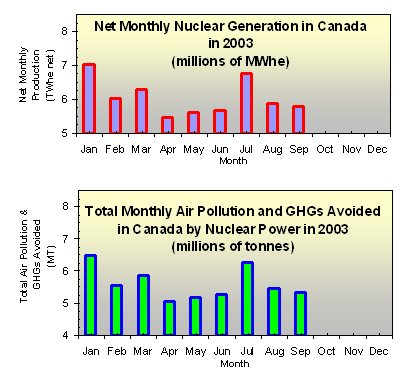|
NOTES:
-
"Total nuclear production" is the total electrical energy supplied
to the grid by Canadian nuclear reactors in the given week, based upon
limited preliminary data courtesy of the CANDU Owner's Group (COG).
"MWh(e) net" = "Megawatt-hours (electrical) net". 1 MWh = 1000 kWh.
-
"Equivalent usage" is an illustrative estimate only,
based upon an average electricity usage of 223 kWh per home per week
(source: Ontario Power Generation). In practice only about 30% of
electricity production (in Ontario) is for residential use; the majority
is for industrial and commercial customers.
-
"Wholesale value" is based upon an estimate of
$0.038/kWh(e) (source: Nucleonics Week, March 1, 2001).
-
"CO2 avoided" is based upon an average
emission of 0.85 tonnes of carbon dioxide per MWh(e) of coal-fired
electricity generation, the principal energy source displaced by nuclear
power in Canada (source: Ontario Power Generation's
solar array energy tracking page).
Carbon dioxide is a "greenhouse gas" that has been proposed by many scientists to be a significant contributor to global climate change.
-
"NOx avoided" is based upon an average
emission of 0.0033 tonnes of nitrogen oxides per MWh(e) of coal-fired
electricity generation, the principal energy source displaced by nuclear
power in Canada (source: Ontario Power Generation's
solar array energy tracking page).
Nitrogen oxides are a
major ingredient of smog, linked to respiratory illness.
-
"SO2 avoided" is based upon an average
emission of 0.0038 tonnes of sulphur dioxide per MWh(e) of coal-fired
electricity generation, the principal energy source displaced by nuclear
power in Canada (source: Ontario Power Generation's
solar array energy tracking page).
Sulphur dioxide is a
contributor to smog (linked to respiratory illness), as well as acid rain (linked to
environmental degradation and property damage).
-
"Particulate air pollution avoided" is based upon an
average emission of 0.0012 tonnes of particulate air pollution per MWh(e)
of coal-fired electricity generation, the principal energy source
displaced by nuclear power in Canada (source: Ontario Power Generation
submission to hearings on its 1989 Demand/Supply Plan).
Particulate air pollution is linked to respiratory illness. Studies estimate the number of
deaths in North America from respiratory illness due to coal-fired
electricity generation in the range of 20 to 100 per GWe-year. In Canada
this suggests that 300 to 1600 people die each year from domestic
coal-fired electricity generation, and that nuclear power, since its
inception in Canada, has saved between 4000 and 20,000 lives by displacing
coal burning. (These figures are illustrative only; in practice, much of
the air pollution found in high-population centres like southern Ontario
is blown in from upwind areas of the United States. In turn, much of the
pollution created in places like southern Ontario is blown into
downwind areas of the United States. Click here for more information from Ontario Power
Generation.)
-
"Total weekly air pollution avoided" is the sum of
the four contributions to air-pollution avoidance listed above. This
number (in tonnes) is roughly the same as total production (in MWhe);
therefore, as a rule of thumb, one may say that in Canada, a kilogram
of air pollution is avoided for every kilowatt-hour of electricity
generated by nuclear power (which would use 20 milligrams of uranium).
This assumes that coal generation is displaced by nuclear generation, as
is currently the case in this country.
|


